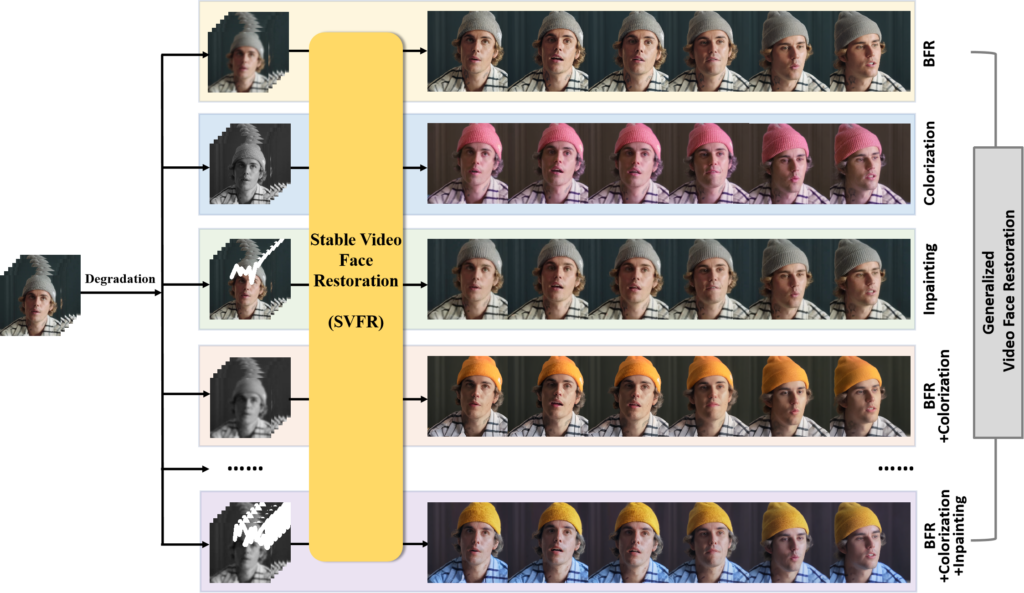In the digital era, videos are an essential part of our lives, from home recordings to cinematic productions. But what happens when poor video quality ruins a precious moment or the expression of a critical face? Enter SVFR (“Stable Video Face Restoration”), an innovative tool that restores faces in videos with unmatched quality and realism, redefining how we preserve our visual memories.
Restoring videos has always been a complex technical challenge, especially when it comes to facial details. Faces are particularly sensitive visual elements; even minor distortions can dramatically alter the perception of a scene. SVFR, developed by Tencent and its research team, leverages the best of neural networks and generative models to transform low-quality videos into surprisingly clear and detailed visual content.
How Does SVFR Work?
The key to SVFR lies in its innovative framework that combines latent transformers and facial landmark prediction. These elements work together to reconstruct and stabilize faces in videos, solving issues like flickering, visual artifacts, and frame-to-frame inconsistencies.
The process begins with a low-quality video as input. SVFR analyzes each frame, detecting key facial features and creating a predictive map based on these references. Then, a neural network model dives into the details, using a combination of 3D VAEs and transformer layers to stabilize and reconstruct the face. This not only improves sharpness but also ensures temporal consistency in the video, a critical factor for the final output to appear natural.
One of SVFR’s standout features is its ability to integrate temporal and spatial cues. This means it doesn’t work frame by frame in isolation but considers how facial movements evolve over time, producing smooth and realistic results. Additionally, the system includes latent regularizations to ensure a more consistent and detailed output.

Practical Applications of SVFR
The practical applications of a technology like SVFR showcase its true impact and reach. From personal to professional use, this tool has the potential to revolutionize how we interact with videos and visual memories.
The possible applications of this technology are numerous and diverse. From restoring old family recordings to enhancing content for platforms like YouTube or TikTok, SVFR offers solutions that go beyond simple image enhancement.
- Restoration of Old Videos: Imagine reviving family memories captured with low-resolution cameras. With SVFR, it’s possible to transform grainy videos into clear images, recovering the genuine expression of people.
- Cinematography and Television: Audiovisual productions could greatly benefit from rescuing key scenes filmed under suboptimal conditions.
- Social Media Applications: Content creators can now recover previously unusable material, improving the quality of their posts and viral videos.
- Forensic Research: In criminal investigations, this tool could analyze surveillance videos or visual evidence with poorly defined faces.
Furthermore, its implementation in mobile applications could allow regular users to access advanced restoration technology with just a few clicks.
What Sets SVFR Apart
While image and video enhancement tools already exist in the market, SVFR stands out for its focus on stability and realism. Many previous solutions produce inconsistent results, where facial details change drastically between frames, creating a “floating face” effect that feels unnatural. SVFR tackles this problem through:
- Facial Landmark Prediction: Ensuring that key features such as the eyes, nose, and mouth remain in their correct positions throughout the video.
- Temporal and Spatial Attention Models: Allowing smooth transitions between frames.
- Diverse Training Data: SVFR is trained on varied datasets that include different types of faces, lighting conditions, and resolutions, enhancing its generalization capability.

Reflecting on the Impact of SVFR
The implementation of SVFR brings up questions beyond the technical realm. With this technology, we are presented with a tool that can redefine how we interact with visual media. But it also raises concerns: To what extent can we trust the authenticity of restored videos? In a world where artificial intelligence is already blurring the line between what is real and generated, SVFR invites us to reflect on the role of technology in preserving memory and visual history.
In the words of SVFR’s creators: “Our goal is not just to enhance visual quality but also to preserve the human essence embedded in every frame.” In this sense, Tencent’s work represents a bold step toward a future where the quality of visual memories is no longer constrained by the technologies of the past.
Explore SVFR for Yourself
If you’re curious to experience this technology, you can try the model in its playground on Replicate. Additionally, the source code and technical details are available on its GitHub repository. These resources not only allow developers to explore the potential of SVFR but also invite the global community to contribute and expand its applications.
SVFR is more than just a tool; it’s a window into the future of digital restoration. In a world where visual quality is increasingly important, innovations like this bring us closer to preserving and enhancing the moments that define our lives. What memories would you improve with this technology? The question is not whether this technology will transform how we view videos, but how profoundly it will impact our collective memory and our perception of what it means to relive the past.
I want make color with my old foto